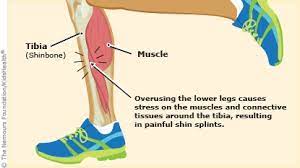Guide to Banishing Shin Splints for Good
Shin Splints
What are shin splints?
Shin splints are a common lower leg injury that causes pain along the shinbone (tibia). They are typically caused by repetitive stress on the shinbone and the connective tissues that attach muscles to the bone. Shin splints can be categorized into two types: medial shin splints, which occur on the inner side of the shin, and anterior shin splints, which occur on the front side of the shin.
Symptoms of shin splints
Recognizing the symptoms of shin splints is essential for prompt diagnosis and treatment. Common signs include pain, tenderness, and swelling along the shinbone. The pain is often described as a dull ache that worsens during physical activity and improves with rest. It’s important to differentiate shin splints from other lower leg injuries, such as stress fractures or compartment syndrome, which may require different treatment approaches.
Risk factors for shin splints
Several factors increase the risk of developing shin splints. These include engaging in high-impact activities like running or jumping, sudden increases in physical activity level or intensity, improper footwear or equipment, and having flat feet or high arches. Additionally, individuals with muscle imbalances, weak shin muscles, or tight calf muscles may be more prone to developing shin splints.
How shin splints are diagnosed
Diagnosing shin splints typically involves a thorough physical examination and a review of the patient’s medical history. Healthcare professionals may also order imaging tests, such as X-rays or MRI scans, to rule out other potential causes of the symptoms. The examination may include checking for areas of tenderness along the shinbone, assessing muscle strength and flexibility, and evaluating gait and foot mechanics.

Preventing Shin Splints
Proper footwear and equipment
Choosing suitable shoes for different activities is crucial in preventing shin splints. Look for shoes that provide adequate support and cushioning for your feet and have good shock absorption. Consider getting orthotics or shoe inserts if you have specific foot conditions or imbalances that contribute to shin splints.
Gradual training and conditioning
One of the key strategies in preventing shin splints is to gradually increase the intensity and duration of your activities. Avoid sudden spikes in your training volume or intensity, as this can overload your muscles and bones and lead to shin splints. Incorporate cross-training and rest days into your routine to allow for proper recovery and reduce the risk of overuse injuries.
Strengthening exercises for lower legs
Strengthening the muscles that support the shins can help prevent shin splints. Include exercises that target the calf muscles, shin muscles, and ankle stabilizers in your workout routine. Examples of effective exercises include calf raises, toe raises, toe taps, and ankle circles. It’s important to perform these exercises with proper form and technique to avoid injury.
Stretching and flexibility exercises
Improving flexibility and reducing muscle tightness can also help prevent shin splints. Incorporate dynamic warm-up exercises before your workouts to prepare your muscles for activity. After your workouts, perform static stretches for the calf muscles, hamstrings, and hip flexors. Stretching can help maintain proper muscle balance and reduce the strain on your shins during physical activity.
Treating Shin Splints
Rest and ice therapy
Rest is crucial in the healing process of shin splints. Avoid activities that worsen the pain and give your body time to recover. Applying ice to the affected area can help reduce inflammation and alleviate pain. Use an ice pack or ice wrapped in a towel and apply it to your shins for 15-20 minutes several times a day.
Pain management techniques
Over-the-counter pain relievers such as ibuprofen or acetaminophen can help manage the pain associated with shin splints. However, it’s important to follow the recommended dosage and consult with a healthcare professional if the pain persists. Alternative methods such as acupuncture or massage therapy may also provide relief for some individuals.</p




